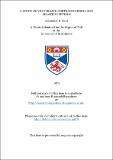Files in this item
A study of vertebrate corticotrophins and related peptides
Item metadata
| dc.contributor.advisor | Scott, D. | |
| dc.contributor.author | Scott, Alexander P. | |
| dc.coverage.spatial | 134 p. | en_US |
| dc.date.accessioned | 2018-07-04T08:12:23Z | |
| dc.date.available | 2018-07-04T08:12:23Z | |
| dc.date.issued | 1974 | |
| dc.identifier.uri | https://hdl.handle.net/10023/14878 | |
| dc.description.abstract | Literature concerning the structure and localisation of ACTH, MSI-1 and related peptides in mammalian pituitaries has been reviewed and the evidence for ACTH-like peptides in non-mammalian vertebrates summarised. The structure of ACTH in non-mammalian vertebrates was studied by bioassay and radioimmunoassay. Corticotrophin immunoreactivity in pituitary extracts from a variety of species was compared with that of natural human ACTH, using five antisera which cross-reacted with different parts of the ACTH molecule. The predominant binding sites of the antisera were determined by studies with synthetic ACTH fragments. Bioactivity and N-terminal immunoactivity were found in pituitary extracts of all species studies, Differences in reactivity with the C-terminally directed antisera indicated structural differences, between corticotrophins of the lower vertebrates, reptilian, avian and mammalian pituitary extracts cross-reacted with C-terminally directed, antisera. Whole reptile and mammal pituitaries were found to contain more C- than N-terminal activity. Determination of the relative concentrations of these activities in rat and guinea-pig pituitary lobes showed that the posterior lobes contained a large excess of C-terminal activity, which released into the media in organ culture. Fluorescent staining indicated that C-terminal activity was located in the pars intermedia. C-terminal immuno-active peptides were isolated from rat and pig pituitaries and a human tumour. On gel filtration they eluted between ACTH a-d a-MSH, and behaved as acidic peptides on ion-exchange chromatography. Amino acid and end group analysis showed that they closely resembled the alpha18-39 portion of ACTH. Consequently they have been termed 'Corticotrophin-like Intermediate lobe Peptide', (CLIP). The significance of the comparative studies with crude pituitary extracts of vertebrate origin and of the C-terminally immunoactive peptide isolated from rat, pig and human pituitaries has been discussed. The close resemblance of the latter to the C-terminal portion of ACTH, and of alpha-NSH to the N-terminal part of the ACTH molecule, suggest that alpha-NSH and the C-terminal peptide are the result of intracellular cleavage of ACTH. Implications of this mechanism have been considered. | en_US |
| dc.language.iso | en | en_US |
| dc.publisher | University of St Andrews | |
| dc.subject.lcc | QP188.P58S3 | |
| dc.subject.lcsh | Pituitary gland | en |
| dc.title | A study of vertebrate corticotrophins and related peptides | en_US |
| dc.type | Thesis | en_US |
| dc.contributor.sponsor | Biotechnology and Biological Sciences Research Council (BBSRC) | en_US |
| dc.type.qualificationlevel | Doctoral | en_US |
| dc.type.qualificationname | PhD Doctor of Philosophy | en_US |
| dc.publisher.institution | The University of St Andrews | en_US |
This item appears in the following Collection(s)
Items in the St Andrews Research Repository are protected by copyright, with all rights reserved, unless otherwise indicated.

